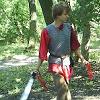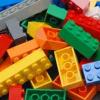Search the Community
Showing results for tags 'train track'.
Found 5 results
-
Apart from analyzing BT protocols, I also do some modding. Sadly, the switches from LEGO are not the best geometry-wise, so I had to take THE SAW and fix it. Off the Beaten Track and Visiting the Neighbors I'll have to do some more butchering for the crossover switches - I need to make a bunch of 8-long straight tracks to get the switches centered in the 64-stud module standard we use. If I use a 16-long track on one side, there is no space left for the motors that operates the switches. At least on one side. And once I get my hands on a Batmobile (or two, or three) and some more PoweredUp! LEDs, the whole stuff will be integrated into the track&train control system I'm building for our layout.
-

An Anatomy of LEGO Train Tracks - a.k.a. Diamond Crossing Design Notes
djm posted a topic in LEGO Train Tech
Context The text within this post is based on an article I originally submitted in September 2014 to RailBricks for consideration to be included in a future issue of RailBricks. In the absence of any RailBricks issue since the article was submitted or recent communication from them, I have elected to post a modified version of the article to this forum. Introduction Figure 1 - Brick built Diamond Train Crossing 13 and 3. Two numbers which are key when building the diamond crossing shown in Figure 1 (the build instructions for which are available for download as a PDF document). Before explaining the numbers further though, a brief explanation of the reason for writing this article. It's not hard to imagine that one of the success factors in LEGO being played with worldwide is the absence of words in their build instructions. Build instructions, such as those for the diamond crossing, are intended to stand on their own without the need for additional commentary. The purpose of this article is to pass on the knowledge gained in the construction of the diamond crossing to other AFOLs. It contains information that is not appropriate to place in building instructions. The desire is to encourage others to experiment further to see what can be achieved in providing alternatives to the standard LEGO PF/IR train track parts. 13 and 3 Explained Figure 2 - Track Cross Section Figure 2 illustrates a cross section of a LEGO standard straight train track, 160 LDraw Units (LDUs) wide, complemented with a couple of extra plates. The image was generated using MLCad [1] and LPub [2]. Each rail has a 20 LDU footprint. The yellow plate was moved from its "correctly aligned" position on the partially obscured stud to its left, 7 LDUs to the right. The right hand side of the plate is touching the left hand side of the top of the rail. Since the rail parts are symmetrical, there are 7 LDUs of "space" on the right hand side of the rail, meaning the rail width at the top is 6 LDUs. Thus aligning a brick to the inside edge of a rail requires an offset of 7 LDUs + 6 LDUs i.e. 13 LDUs. Figure 3 - Solution Concept Figure 3 illustrates the concept of what needs to be built to achieve the same spacing as that between the two rails on a standard LEGO track part. Didier Enjary's advanced building guide [3] is a useful source of information about different techniques to obtain offsets. However, the offsets identified are even numbers, which won't combine to produce the desired offset of 13 LDUs. One of the answers posed to a question about how to achieve a 1 LDU offset [4] identified that there is a LEGO part that provides an odd valued LDU offset. The Minifig, Neck Bracket with Back Stud (42446) [5], as illustrated in Figure 4, produces a desirable odd value offset of 3 LDUs. Figure 4 - LDU Offset Bracket Built from inside to outside Figure 5 - 94 LDUs separation The crossing is built from the inside towards the outside. A fundamental principle was to create the equivalent gauge to a real track piece by obtaining a separation between bricks of 94 LDUs. Figure 3 illustrates where this LDU measurement comes into play. Figure 5 illustrates a combination of pieces from the crossing that achieves the desired spacing. Other brick combinations exist that provide the same separation. Potential for Re-use The diamond crossing is built, fundamentally, as a straight through track with a diagonal track attached to each side using a Technic angled connector. This approach yields a high potential for re-use of the straight through section if building a differently angled crossing, as follows. remove the diagonal tracks (see Figure 6) replace the angled Technic connector (highlighted in Figure 6) with one of a different angle for the hinge connectors' forming the internal diamond, alter their angle appropriately. This will also likely require a rework of the parts which form the diamond as a different length of track will be required for a different angle (see blue highlights in Figure 7). tweak the bricks used where the tracks join to adjust the length where necessary (see red highlights in Figure 7). Figure 6 - Straight Through Track Figure 7 - Adjustments required if angle changed Other Notes The crossing is built by creating a brick separation of 94 LDUs, working from the inside of the track to the outside of the track. At one point during construction, an alternative approach yielded an offset of 13 LDUs when combined with a baseplate, as illustrated in Figure 8. This approach was not explored further but does offer the potential for constructing a crossing on the basis of from the outside to the inside. Readers are encouraged to experiment to see whether a suitable crossing can be built using this approach. There is no guarantee that the approach will yield a usable crossing. Figure 8 - Candidate for an outside to inside build The crossing uses one part that is no longer in production; the "Hinge Plate 1 x 2 with 3 Fingers" [8]. It may be possible to use the "Plate, Modified 1 x 2 with Handle on End - Closed Ends" [9] instead. During the design evolution of the crossing, both parts were trialed in different versions. In the end, the decision was made that the profile (see figure 9) of the hinge plate provides a better functional fit than that of the modified plate. Figure 9 - Hinge Plate and Modified Plate Profile The key measurements 13 and 3, identified in this article, may be usable to build straight tracks suitable for use with the curved "narrow" rail track [7]. This has not been explored. Conclusion The primary purpose of this article has been to disseminate the knowledge gained about significant LDU measurements applicable when building a custom PF/IR train track diamond crossing. Armed with these measurements, the AFOL train community may be able to derive further track piece alternatives. References [1] Mike's LEGO CAD http://mlcad.lm-software.com/ [2] LPUB http://sourceforge.net/projects/lpub4/ [3] The Unofficial LEGO Advanced Building Techniques Guide. 2007, Didier Enjary. http://photos.freelu...B/SBv1.pdf.html [4] How to make a 1 LDU offset http://bricks.stacke...-a-1-ldu-offset [5] Catalog: Parts: Minifig, Body Wear: 42446 http://www.bricklink...tem.asp?P=42446 [6] Catalog: Parts: Technic, Plate: 4262 http://www.bricklink...Item.asp?P=4262 [7] Catalog: Parts: Train, Track: 85976 http://www.bricklink...tem.asp?P=85976 [8] Catalog: Parts: Hinge: 4275 http://www.bricklink...Item.asp?P=4275 [9] Catalog: Parts: Plate, Modified: 60478 http://www.bricklink...tem.asp?P=60478- 21 replies
-
- design notes
- diamond crossing
-
(and 1 more)
Tagged with:
-
I was just driving LEGO trains on a LEGO-exhibiton here in Budapest when an idea came to my mind, I really would like to share it with the Train Tech community. I've read Holger Matthes' smooth curves article in Railbricks 1 long time ago, today I played with some straight track segments, building the well-known smooth curve using jumper plate, 1×2 plate and 1×4 plate. Then I looked at a really useful part in the display, this one: Bracket 1*2 - 2*2 And built it's narrower part between the track segments: The studs of the 4 LDU wide part perfectly holds the plate of the track segment (okay, it's illegal connection, but works perfectly), between the 1×2 plate part of the bracket and the other track segment you have to place a single 1×1 or 1×2 plate. The inner side of the curve can be connected with a single 1×2 plate below the track plates, or below and above them, too. Doing some math, calculating the theoretical radius: We have an isosceles triangle, equal sides with 140 LDU distance (LEGO Digital Unit, 1 stud = 20 LDU, 1 brick = 24 LDU, one plate = 8 LDU), the shortest side is 4 LDU long. (Please note, that the bracket brick is inserted by stud 2, not 1 between the tracks, counting studs from outer side of the curve). The half of the isosceles triangle described above is a right triangle, with hypotenuse 140 LDU long and a shorter leg 2 LDU (half of 4 LDUs). The angle opposite of the 2 LDU side is the half of the angle between the tracks, let's name it a. sin a = 2 LDU/140 LDU sin a = 0,0142857 a = 0.8185 degrees 2*a = 1.637 degrees, this is the angle between the two segments. For 90 degress you need 54,97, so 55 connections, which means 56 straight tracks. Lenght of 56 straight tracks is approx. 718 cm (including connections), so the radius is: 716 cm = ( 2*r*PI ) / 4 (it is only a quarter of a full loop) r = 456 cm It could be quite impressive, if you have enough space for a curve like this. If anybody has enough straight and parts to make a try, please do it, my train tracks are reserved for two more weeks. Please discuss!
-
So... what's going on? Big Ben's Page is dated from January, 2013: "Please check back for further updates in the coming months." Is 11 of them enough to wait to nag? And then ME Models just ran out and hasn't made any more available. I understand they run up against QC issues, which is understandable... but frankly, those ME Model rails worked great for me, I don't understand what the problems could be. Were there any other alternatives out there? Anybody with any news about Big Ben and ME?
- 7 replies
-
- 9v
- train track
-
(and 2 more)
Tagged with:
-
This is more of a wish list topic, but please, oh please why can't we get more train track varieties ? I'm new to the train Lego them and thus only using PF tracks, but I really wish you could get more functional type tracks, (affordable) crossover, t-junctions, ramps, x-junctions, and + junctions (like 12volt) .. .. Do you think Lego will release more variety ? Re-release crossover tracks ? And why not ? anybody have any insights into the limited range of tracks ? is it just cost of production ?
- 21 replies
-
- train
- train track
-
(and 1 more)
Tagged with:




